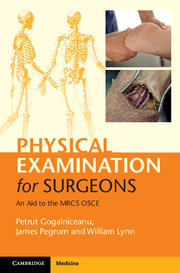Book contents
- Frontmatter
- Dedication
- Contents
- List of contributors
- Introduction
- Acknowledgments
- List of abbreviations
- Section 1 Principles of surgery
- Section 2 General surgery
- Section 3 Breast surgery
- Section 4 Pelvis and perineum
- 10 Examination of the anus
- 11 Examination of the pudendum and vagina
- 12 Examination of the penis
- 13 Examination of the scrotum
- Section 5 Orthopaedic surgery
- Section 6 Vascular surgery
- Section 7 Heart and thorax
- Section 8 Head and neck surgery
- Section 9 Neurosurgery
- Section 10 Plastic surgery
- Section 11 Surgical radiology
- Section 12 Airway, trauma and critical care
- Index
12 - Examination of the penis
from Section 4 - Pelvis and perineum
Published online by Cambridge University Press: 05 July 2015
- Frontmatter
- Dedication
- Contents
- List of contributors
- Introduction
- Acknowledgments
- List of abbreviations
- Section 1 Principles of surgery
- Section 2 General surgery
- Section 3 Breast surgery
- Section 4 Pelvis and perineum
- 10 Examination of the anus
- 11 Examination of the pudendum and vagina
- 12 Examination of the penis
- 13 Examination of the scrotum
- Section 5 Orthopaedic surgery
- Section 6 Vascular surgery
- Section 7 Heart and thorax
- Section 8 Head and neck surgery
- Section 9 Neurosurgery
- Section 10 Plastic surgery
- Section 11 Surgical radiology
- Section 12 Airway, trauma and critical care
- Index
Summary
Checklist
WIPER
• Patient supine. Trousers removed. Groins and genitals exposed. Chaperone as required.
Physiological parameters
Inspection
• Penile shape: chordae, priapism
• Presence or absence of foreskin (circumcision)
• Retract foreskin (if uncircumcised): phimosis, paraphimosis, tight frenulum
• Position of external meatus: normal, hypospadias, epispadias
• Lesions on glans: carcinoma, papillomata acuminata, balanitis, ulcers (chancre)
• Lesions on inner or outer foreskin: as above
Palpation
• Open external meatus to assess size of urethral opening:
• discharge (urinary incontinence, pus, blood)
• erythema/ulceration
• pinhole meatus
• Palpate glans and shaft of penis: evidence of Peyronie's disease.
• Palpate urethra: urethral stricture, carcinoma, diverticulum or abscess.
To complete the examination…
• Palpate inguinal lymph nodes: particularly in the presence of a penile lesion.
• Perform a scrotal, perineal and rectal examination.
• Urine dipstick.
Examination notes
What are the essential history points prior to a penile examination?
• Nature of lesion
• Circumcised or not
• Effect of erection on lesion
• Sexual history including erectile function and risk of sexually transmitted infections
What do you look for on inspection?
Assess whether the patient is circumcised. If the patient is not circumcised it is important to retract the foreskin to expose the glans. This allows inspection of the glans as well as the inner surface of the prepuce for any suspicious lesions. One needs to assess the position of the external urethral meatus.
What do you palpate in a penile examination?
Assess the actual diameter of the urethral opening deep to the external meatus, as a pinhole meatus may be present despite an apparently large external orifice. This is best performed by gently squeezing the tip of the glans in the anteroposterior axis, which encourages the slit-like urethra to open into a circular orifice.
The glans and shaft of the penis need to be palpated. There may be palpable fibrotic plaques on the penile shaft suggestive of Peyronie's disease. Gross urethral lesions in the penile shaft may also be palpable.
- Type
- Chapter
- Information
- Physical Examination for SurgeonsAn Aid to the MRCS OSCE, pp. 109 - 111Publisher: Cambridge University PressPrint publication year: 2015



